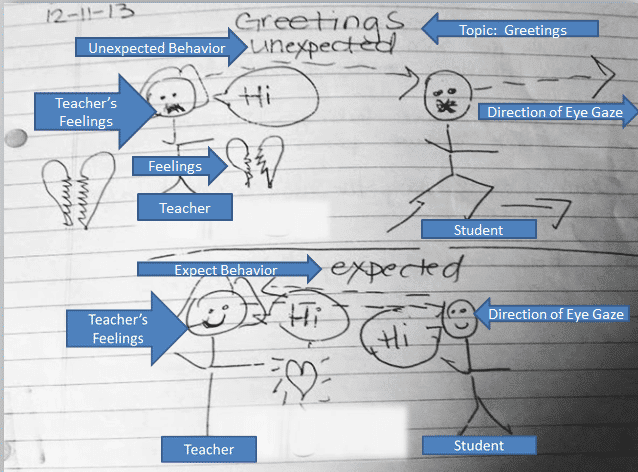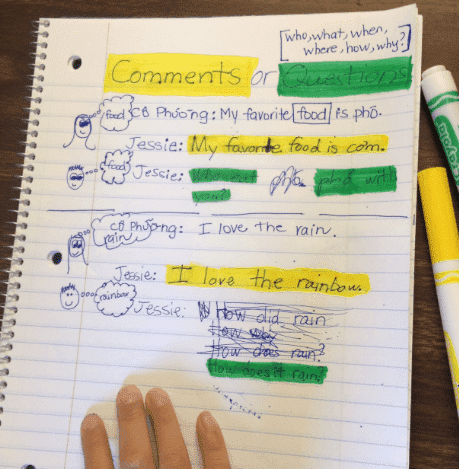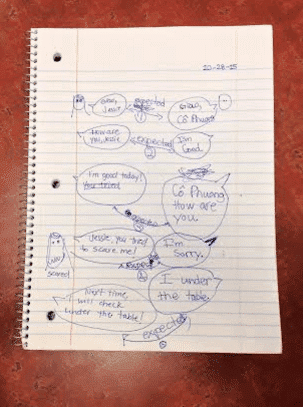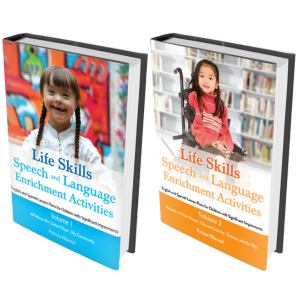How to address conversational skills in speech therapy is a very hot topic that we address in our ASHA CEU course: Considerations for Autism for Speech-Language Pathology. Based on my work (SLP, ABA therapist, autism specialist), here are the skills I address (in order) when working with students/clients with autism (toddler-age through adulthood).
1. Joint Attention
The foundation of conversational skills is joint attention. So, I make sure to address this first. Often, people talk about lack of eye contact. For me, it’s not just the eye contact. It’s knowing that other individuals have thoughts that are independent of the client/student perspective, and eye contact is means to show what/who people are thinking about with their eye gaze. I play games (Eye on the Prize and Walk with Me) to increase joint attention.
2. Make it Visual
Oftentimes, our students/clients with autism learn visually. So, for me, if it’s not shown visually, the skill addressed will not improve. I break down the skills into what the unexpected behavior “looks like” and “sounds like”. I do this by drawing out the unexpected behavior. I use thinking bubbles and conversational bubbles to convey the outcomes. Then, I draw out the expected outcomes.
This is our opportunity to talk about what the skill “looks like” and “sounds like.” Here is an example of addressing greetings. In this case, the student did not say “hi” to me. Then, we talked about what it looked like to use appropriate greetings. Notice the talking bubbles to explicitly show what should be stated.

To really develop conversational skills in speech therapy, I break it down into multiple skills. Here are some of the skills I address to work on with the overall goal of conversation:
- Thinking with others with your eyes
- Spacing
- Initiating with comment or question
- Friend files (thinking about the topics that would be of interest to the communication partner)
- Making comments of appropriate topic
- Making comments of appropriate length
- Asking questions
- Concluding a conversation
Here is a visual of how we worked on “comments and questions.”

At the start of every session, I always start by checking in with my students/clients by asking “What’s up?” This is their time to tell me a brief synopsis of something that happened in their day. Here, I draw out the whole conversation. Then, we go back and determine if the comments were expected or unexpected. I use a red marker (to show unexpected conversational behaviors) or green marker (to show expected conversational behaviors) when needed.

Once we draw out the unexpected and expected skills, we practice the expected conversational skills in speech therapy. So, let’s say you’re working on commenting on topic, you could practice be bringing up topics, and the student needs to respond on topic. For fun, I’ll pull topics out of my rainbow bag or a hat!
Additionally, for the practice, it’s important to reach out to the family and teachers to let them know what skill you’re working on. If they can also address the same content in class or at home, it yields some meaningful generalization. For me, I like to use a spiral notebook for each of the visual lessons.
Over time, we fill pages and pages with social skills lessons. And the notebook is always in the student’s backpack. I talk to the teacher and parent so that they know that it’s in there. They know the exact skill we are working on, and they get to see what it looks like. Overtime, we have pages and pages of skills. The best is when the student/client starts to pull out the notebook, go to the skill that he needs to work on and independently demonstrates the skill!
Resources:




